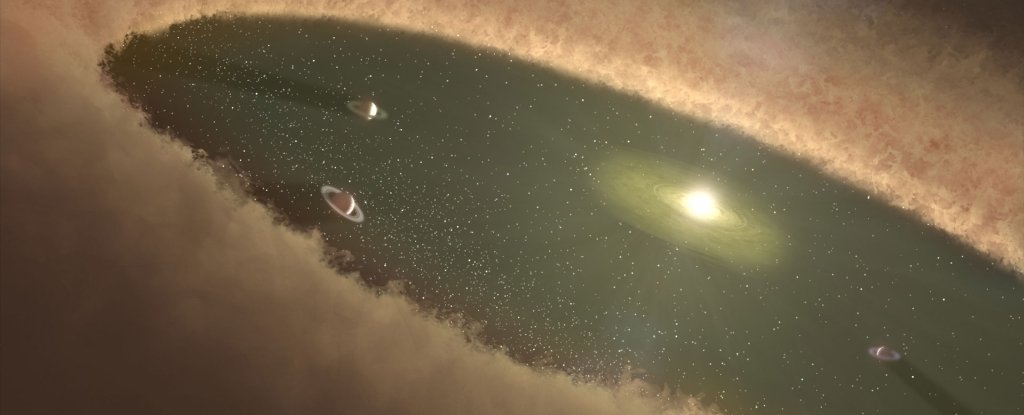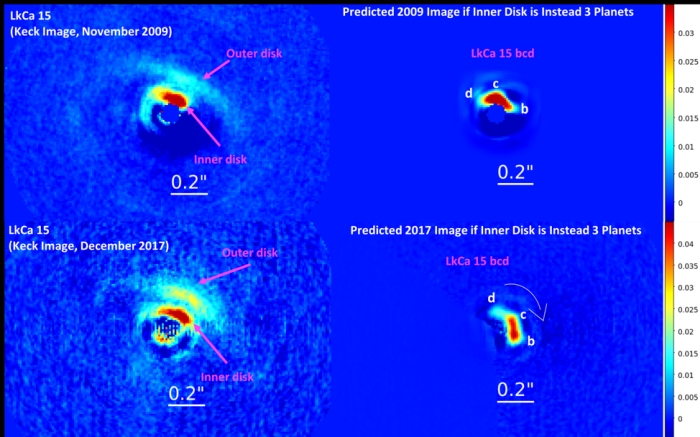Using the combined might of two of Hawaii’s powerful telescopes, astronomers have captured what they are describing as “groundbreaking” sharp new images of a planetary system still in the process of being born. 

They also found no evidence of three previously detected planets. The star is LkCa 15, a young, Sun-like T Tauri star 473 light-years away, and the missing planets are not a bad thing. Nor do they mean that no planets are forming.
Instead, the technique demonstrates a refinement of previous methods that could allow for more accurate detection of still-forming planets in the future – and deeper understanding of planetary formation.
We know that when stars are newly formed, they’re orbited by a swirling disc of dust, rocks and gas. Planetary accretion is thought to occur when particles in the disc collide with each other, gradually growing stronger and stronger gravitationally, collecting and clearing more and more material from the orbital path, and eventually forming a planet.
Astronomers in the past have taken some pretty amazing images of these protoplanetary disks, with strong evidence of that orbital clearing.
In addition, previous teams of astronomers thought that they had detected evidence of three ‘super-Jupiter’ planets in orbit around LkCa 15 in just such a Solar System-sized gap, using a technique called sparse aperture masking interferometry to separate the planets’ light from the light of the star.
But, using the Subaru Telescope and the WM Keck Observatory, an international team of researchers has determined that the putative planetary light was actually coming from the disc itself all along.

Nope, no planets here. (Keck Observatory)
An easy mistake to make, apparently.
“LkCa 15 is a highly complex system,” said astrophysicist Thayne Currie of NASA-Ames Research Center and the Subaru Telescope.
“Prior to analyzing our Keck and Subaru data and given the same prior aperture masking data, we also would have concluded that LkCa 15 has three detected superjovian planets.“
The observations were very thorough. On the Subaru Telescope, the team used a new, cutting-edge planet imaging instrument, the Subaru Coronagraphic Extreme Adaptive Optics (SCExAO), attached to the Coronagraphic High Angular Resolution Imaging Spectrograph (CHARIS), to obtain images of the disc in near-infrared.
On the WM Keck Observatory, the Near-Infrared Camera (NIRC2) was used to take images at the longer wavelengths emitted by young planets. And, in the Keck archive, the team found images of the system taken by NIRC2 in 2009. These were used for comparison.
What all this data showed – both the archived data and the new observations – is that most of the light emanating from around LkCa 15 is from the arc-shaped visible edge of a section of the disc, which had the same brightness previously attributed to protoplanets.
But that doesn’t mean there aren’t any planets there. The team thinks there probably are, but they’re just a bit smaller and dimmer than we can detect – the size of Jupiter or Saturn, maybe, rather than huge super-Jupiters.
And, if we could find them, they could help us better understand the planetary formation process, not just in general, but as it pertains to our own home system.
“The planets in this infant solar system could actually be a lot more like our own Solar System than previously thought,” Currie said.
“They are certainly there somewhere, possibly embedded in the disc. We will keep trying to find them.”
The research has been accepted into The Astrophysical Journal Letters and has been published on arXiv.

